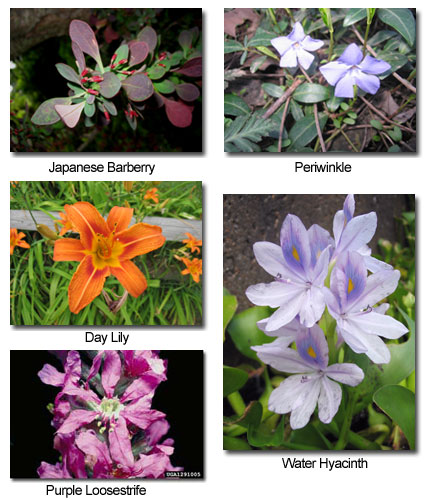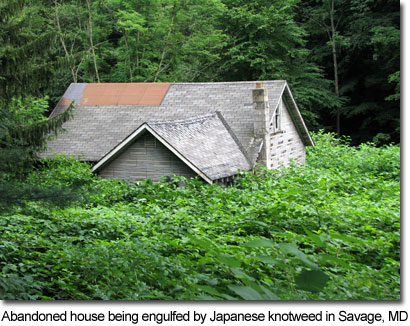
When you go to the nursery, you might have the best intentions of redesigning your landscape to attract wildlife. However, not all plants sold in nurseries and at stores are good for wildlife and the environment. When selecting plants for backyard wildlife habitat, native species are generally the best choices. Unfortunately, native species are not always readily available at most commercial nurseries. So, your best plan of action is to go to the store armed with knowledge to avoid purchasing problem plants. To begin, let’s define what is considered to be native, non-native and invasive.
-
Native: species which naturally occur in a region (like Maryland)
-
Non-Native: species which do not naturally occur in a region
-
Invasive: non-native species that cause environmental, economic or health-related problems
Invasive species are problematic, and their introductions into natural systems can be intentional or unintentional. Invasive species can be animals, plants, fungi and even microbes. Billions of dollars are spent each year in the United States to control invasive species. It has been estimated that $45 million per year is spent on control of the invasive Purple loosestrife (Lythrum salicaria) on federal lands. That’s a lot of cash!

One way you can help with the battle against invasive plants is to not plant them in your yard. The following list contains species currently sold at nurseries that should be avoided. It should be noted that not all non-native plants are invasive, and there are plenty of non-native plants which can be used to enhance your backyard wildlife habitat. Check out pages found on the
Wild Acres site here for more information on desirable species for wildlife.
As of 2011, the Maryland Invasive Plants Prevention and Control Law was passed. The law designates certain invasive plants as either Tier 1 (illegal to propagate, import, transfer, sell, purchase, transport, or introduce any living part of a Tier 1 invasive plant in Maryland) or Tier 2 (legal to sell but with proper signage indicating invasiveness). Each species is classified using a detailed weed risk assessment analysis. The listing process is on-going, and current information on the law and listed species can be found here:
mda.maryland.gov/plants-pests/Pages/maryland_invasive_plants_prevention_and_control.aspx
Some of Maryland’s Problem Plants
Habit |
Common Name |
Scientific Name |
Tier Status |
Aquatic | Eurasian watermilfoil |
Myriophyllum spicatum | |
Aquatic | Parrot feather |
Myriophyllum aquaticum | |
Aquatic | Water chestnut |
Trapa natans | |
Aquatic | Water hyacinth |
Eichhornia crassipes | |
Forbs | Carpet bugleweed, Bugleweed, Ajuga |
Ajuga reptans | |
Forbs | Japanese pachysandra, Pachysandra |
Pachysandra terminalis | |
Forbs | Loosestrife, Creeping Jenny, Moneywort |
Lysimachia nummularia | |
Forbs | Orange daylily |
Hemerocallis fulva | |
Forbs | Perilla, Beefsteak plant |
Perilla frutescens | |
Forbs | Yellow archangel |
Lamiastrum galeobolon | |
Forbs | Yellow flag iris |
Iris pseudacorus | Tier 1 |
Grass | Cogongrass |
Imperata cylindrica | |
Grass | Common reed |
Phragmites australis | |
Grass | Japanese silver grass |
Miscanthus sinensis | |
Grass | Johnson grass |
Sorghum halepense | |
Grass | Pampas grass |
Cortaderia selloana | |
Shrub | Butterfly bush |
Buddleia davidii | |
Shrub | Chinese privet |
Ligustrum sinense | Tier 2 |
Shrub | Heavenly bamboo, Nandina |
Nandina domestica | Tier 2 |
Shrub | Japanese barberry |
Berberis thunbergii | |
Shrub | Japanese holly |
Ilex crenata | |
Shrub | Japanese spiraea |
Spiraea japonica | |
Shrub | Leatherleaf mahonia |
Mahonia bealei | |
Shrub | Scotch broom |
Cytisus scoparius | Tier 2 |
Shrub | Linden viburnum, doublefile viburnum or Japanese snowball, and Siebold viburnum |
Viburnum dilatatum, V. plicatum, and V. sieboldii | |
Shrub | Wineberry |
Rubus phoenicolasius | |
Shrub | Winged euonymus |
Euonymus alatus | Tier 2 |
Tree | Amur corktree, Phellodendron |
Phellodendron amurense | |
Tree | Bradford pear |
Pyrus calleryana | Tier 2 |
Tree | Chinese tallow |
Triadica sebifera | |
Tree | Goldenrain tree |
Koelreuteria paniculata | |
Tree | Norway maple |
Acer platanoides | |
Tree | Sawtooth oak |
Quercus acutissima | |
Vine | Chinese wisteria, Japanese wisteria |
Wisteria sinensis, W. floribunda | Tier 2 |
Vine | Chocolate vine |
Akebia quinata | |
Vine | English ivy |
Hedera helix | |
Vine | Periwinkle |
Vinca minor | |
Vine | Vinca vine |
Vinca major | |
Vine | Winter creeper |
Euonymus fortunei | Tier 1 |
It should be noted that this is not an exhaustive list, but these are some of the more commonly planted problem plants. When in doubt, research the plant you are interested in to see if it is invasive. The Maryland Invasive Species Council (MISC) also has good information on invasive species in Maryland as well as well as the National Invasive Species Council.
For more information, please contact:
Maryland Department of Natural Resources
Wildlife and Heritage Service
Tawes State Office Building, E-1
Annapolis MD 21401
410-260-8540
Toll-free in Maryland: 1-877-620-8DNR
[email protected]
Acknowledgements:
- Purple Loosestrife Flowers, courtesy of Linda Wilson, University of Idaho
- All other photographs by Kerry Wixted